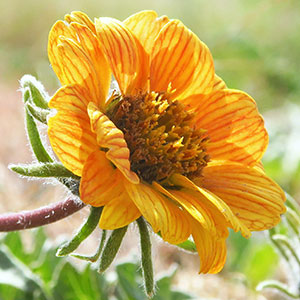Balsamorhiza rosea
Balsamorhiza deltoidea
rosy balsamroot
deltoid balsam root, Puget balsamroot
blades gray-green, oblong to lance-ovate, 3–10(–20) × 2–5 cm (rarely pinnately lobed), bases weakly cordate or truncate, margins crenate to serrate, apices rounded to acute, faces finely strigose to moderately scabrous (usually gland-dotted as well).
blades green, deltate or rounded-deltate to triangular-deltate, 10–25+ × 7–15(–20) cm, bases cordate to sagittate, margins usually crenate to dentate (at least near bases), sometimes entire, apices acute, faces usually sparsely hirtellous to hispidulous, sometimes glabrous (usually gland-dotted, sometimes vernicose).
hemispheric, 18–20 mm diam.
campanulate to hemispheric 15–30+ mm diam.
(becoming brick-red, often drying to pink or rose, and chartaceous) (8–)15(–25) mm (hispidulous abaxially; cypselae strigose).
20–50 mm.
deltate or ovate to lanceolate, 8–12 mm, not surpassing inner.
oblong to lanceolate or lance-linear, (12–)30–40(–60) mm, usually much surpassing inner, apices acute.
usually borne singly.
usually borne singly, sometimes 2+.
= 38.
= 38.
Balsamorhiza rosea
Balsamorhiza deltoidea
In a hybrid swarm involving Balsamorhiza rosea and B. careyana, B. rosea remains relatively uncontaminated; the dominance among the hybrids appears to lie with B. careyana. A record of a hybrid between B. rosea and B. careyana from the Spokane area is doubtful.
(Discussion copyrighted by Flora of North America; reprinted with permission.)
Balsamorhiza deltoidea varies in the crenation of the leaf margins. The variability may stem from an old hybridization with B. hookeri or other species of Balsamorhiza. Otherwise, B. deltoidea shows little significant variability except where it hybridizes with B. careyana in the narrows of the Columbia River Gorge.
(Discussion copyrighted by Flora of North America; reprinted with permission.)
- Local floras:
BC,
CA,
OR,
WA
- Local Web sites:
CalFlora,
CalPhotos,
Flora NW,
PNW Herbaria,
Turner Photog.
WildflowerSearch
iNaturalist (observations)
USDA Plants Database
- LBJ Wildflower Center
- SEINet
- Plants of the World Online
- Encyclopedia of Life
- Wikipedia
- Google Image Search


